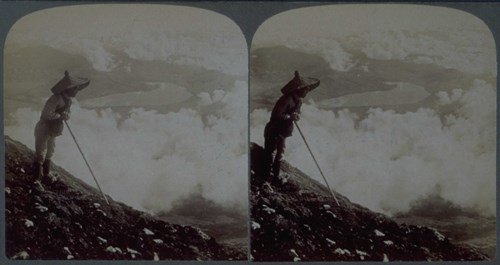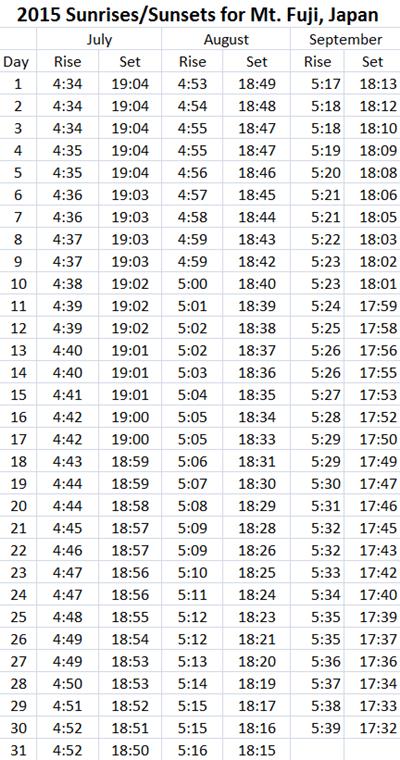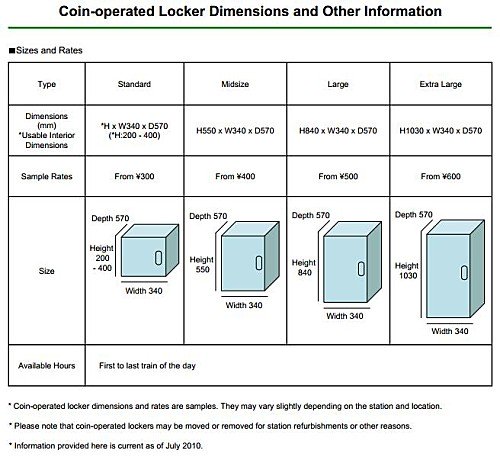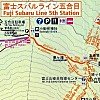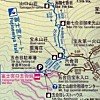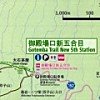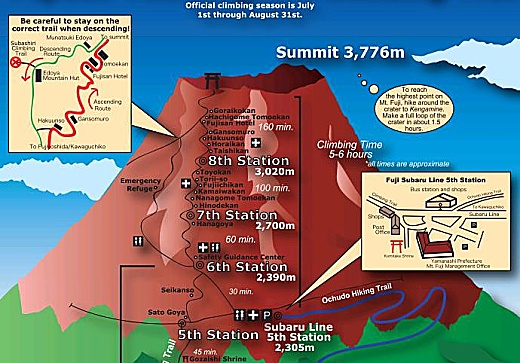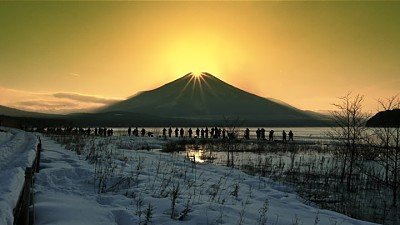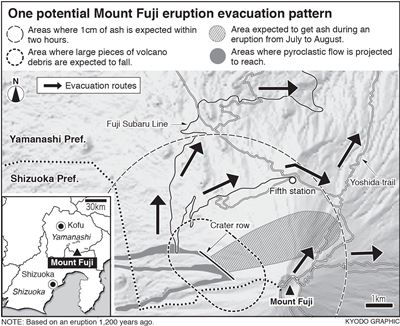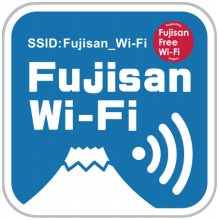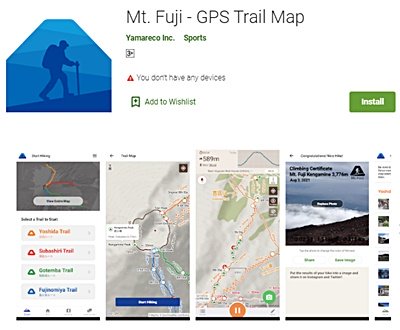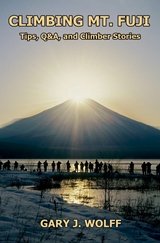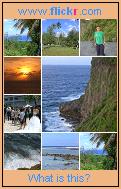Frequently Asked Questions (continued from Page 1): Q: Is it possible
to
climb to the summit of Mt. Fuji from the base of the mountain?
(updated
July 12, 2018) Q: Is it possible to climb to the summit of Mt. Fuji from the base of the mountain? (updated July 12, 2018) A: Yes, indeed. Since most climbers start from the 5th Station, if you want to escape the crowds and surround yourself with a quiet, breathtaking forest, you should seriously consider the historic Yoshidaguchi Climbing Trail, which starts from the northern base of Japan's highest peak. The original Yoshida Climbing Route starts from the Fuji Sengen Shrine (formally known as Kitaguchi Hongu Sengen Jinja), where the pilgrims of over 500 years ago came to pray before they started their climb up the sacred mountain. Today, traditionalists claim that the only way to climb Mt. Fuji is from the Fuji Sengen Shrine (elev. 850m), which is designated as a national cultural asset and part of Mt. Fuji’s June 22, 2013 registration as a World Heritage Site. But many climbers hike from Umagaeshi, from where it only takes two and a half hours to reach the 5th station. Located just below the 1st Station and easily accessible by bus, Umagaeshi is a great starting point to climb Mt. Fuji. Recently there has been a surge of people starting their climb from Umagaeshi because it provides a much more traditional and historical climbing experience, free from the hordes of climbers above the 5th Station. Bus service from Mt. Fuji Station (formerly Fujiyoshida Station) is available to the Fuji Sengen Shrine, and up the road to Naka-no-Chaya and Umagaeshi. (A special thanks to Robin, the former Coordinator for International Relations at Fujiyoshida City Hall for kindly sharing this info.) 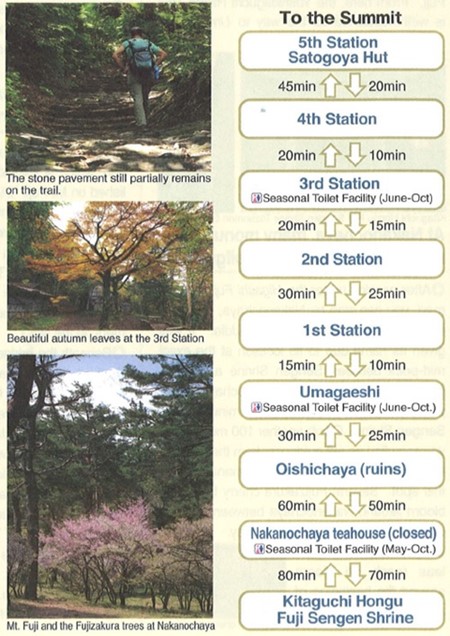 Yoshidaguchi Climbing Trail hiking times (Click image above to view more details, including trail map) Courtesy: Robin at Fujiyoshida City International Affairs Desk A brochure published in Nov. 2013 by Fujiyoshida City shows even more details about this pilgrimage route and can be viewed here. Q: What time is sunrise and sunset during the Mt. Fuji climbing season? (updated Mar. 24, 2025) A: Sunrise/sunset times for the 2025 Mt. Fuji climbing season are exactly the same as shown below or vary by only a minute or 2. Q: Can I leave my large backpack in a locker at the train station and take only a smaller pack with me to climb? (updated July 24, 2025) A: The availability of coin lockers depends on a number of factors, including the trail you take, day of week, and time of day of your climb, all of which will affect how crowded it is at the time. You should be aware, though, that the number of coin lockers large enough for backpacks is usually quite limited, and may be all filled during peak times. According to the City of Fujiyoshida, some coin lockers for large luggage are available at both Mt. Fuji Station and Kawaguchiko Station (operated by the Fuji Kyuko Line) and at the Fuji Subaru 5th Station. Although, they warn that sometimes people have had problems storing large hard-shelled luggage. The starting cost is ¥300/day. It may also be possible for arrangements to be made at either the Mt. Fuji or Kawaguchiko Tourist Information Centers. The chart below shows the sizes and costs for coin lockers typically found at train stations operated by JR East, although all sizes may not necessarily be available at the smaller train stations in the Mt. Fuji area. On the following train station maps, you can see the locations of coin-operated lockers that are available there: Shinjuku Station: http://www.jreast.co.jp/e/stations/e866.html Tokyo Station: http://www.jreast.co.jp/e/stations/e1039.html If you're climbing Mt. Fuji during peak climbing times (especially July 21 - Aug. 20), I think the chances of finding a coin locker for large-sized luggage at the Mt. Fuji 5th Station trailhead would probably be somewhere between slim and none.  I think you might have better luck leaving your stuff at Shinjuku or
Tokyo
Stations, where you can use the coin lockers there for up to 3 days
(from ¥300/day). "Days" are counted from 12:00 am to 11:59 pm (not
24-hr. periods from the time you insert ¥100 coins to pay for the 1st
day) and they
check the lockers everyday, and so if your stuff is not out after 3
days, it's taken to an office where you can claim it and pay the
extra charges upon your return.
I think you might have better luck leaving your stuff at Shinjuku or
Tokyo
Stations, where you can use the coin lockers there for up to 3 days
(from ¥300/day). "Days" are counted from 12:00 am to 11:59 pm (not
24-hr. periods from the time you insert ¥100 coins to pay for the 1st
day) and they
check the lockers everyday, and so if your stuff is not out after 3
days, it's taken to an office where you can claim it and pay the
extra charges upon your return. 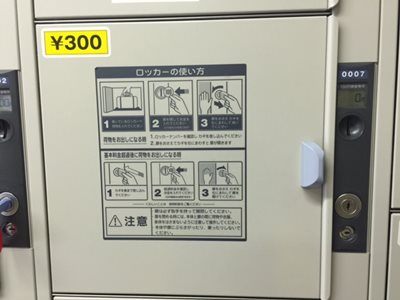 Japanese train station coin locker Also, if you stay at a hotel at the base of the mountain, you could possibly leave your pack at the hotel during your climb. Another option might be that, while climbing Fuji-san, some climbers have their suitcases shipped to their next destination by "takkyubin" (local ground transport service, like UPS in the states). July 24, 2025 update: Several coin lockers are available outside the west side of the Kawaguchiko Station building, although it's unclear how many of them are big enough for large-size backpacks. There are also a number of other baggage storage services available near the station. 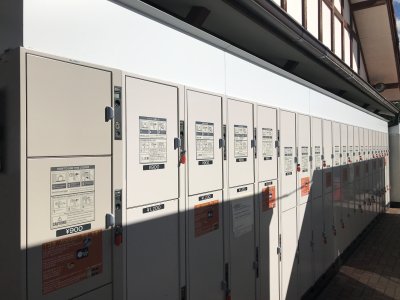 Coin lockers outside Kawaguchiko station Q: What kind of coin lockers do they have at the Fuji Subaru Line 5th Station? (updated Mar. 31, 2018) A: There are at least 200 coin lockers inside the Unjokaku Lodge, located right where you get off the Keio highway bus from Shinjuku. But only 12 of the 70 coin lockers that are in the 1st floor souvenir shop are large enough (34 cm wide x 76 cm high x 50 cm deep) for a backpack and they cost ¥600. The small-size (34W x 30H x 42D) and mid-size (34W x 39H x 42D) coin lockers cost ¥300 and ¥500, respectively. The other 130 coin lockers are on the 3rd floor, along with the coin showers, separate capsule bed rooms for men and women, and the larger community rooms for rest or overnight stay. Please note that these coin lockers are only accessible from 7 am till 10 pm. There are also coin lockers inside the Fujisan Miharashi shop and restaurant, a photo of which you can view on this page. 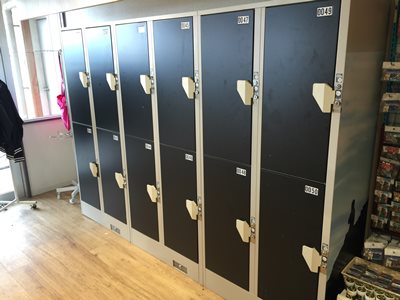 Large-size coin lockers inside the Unjokaku Lodge Q: Where
can I find a comprehensive checklist of tips on "How to Climb Mt.
Fuji"? Q: Do
I have to worry about altitude sickness when climbing Mt. Fuji? Q: What
should I do if I have
an accident, get sick, or have any other kind of trouble or
emergency? (updated
May 13, 2024) Let's be clear, Mt. Fuji can be quite dangerous, and between 2011 and 2014 has claimed on average nearly 8 lives per year. Overconfidence results in deaths and injuries on Mt. Fuji every single year. Q: Are
there any live webcams showing Mt. Fuji? (updated July 22, 2025) (Japan time = UTC + 9 hrs.)
Q: Where
can I find a good route map or elevation profile for climbing Mt.
Fuji? (updated
Sept. 1, 2025)
In the above 4 maps, the
enlargement of the Mt. Fuji summit area can be seen here: Ohachimeguri (お鉢めぐり) trail map
Here are some additional helpful maps: - 2025 trail map for the main Yoshida
Trail, issued by the Mt. Fuji Enviromental Preservation Council One of the best
internet maps, in my humble opinion, My Google Map of the 25 Highest Mountains in Japan(zoom out to see all of the other highest
mountains in Japan)
|
|||||||||||||||
| "Parents
should think twice before pushing their children to scale Mount Fuji.
More than half of the children who attempted to reach the summit of the
iconic mountain developed symptoms of acute altitude sickness, a
Japanese medical society survey found... Of the respondents, 55 percent
said they had developed common symptoms of acute mountain sickness such
as headache, nausea and dizziness, and half of the children had given
up trying to reach the summit... At its worst, altitude sickness can
result in death." —Asahi Shimbun, June 20, 2014— |
Q: I'm looking for a Mt. Fuji climbing partner. Are there some online forums where I can hook up with other climbers? (updated Aug. 7, 2025)
A: These links are in a constant state of flux, but I'll try to keep them current. Please send me hate mail if you encounter a 404 error:

"Climbing Mt. Fuji" Facebook group (has recently become quite active in 2025)
Trip Advisor Fuji Travel Forum
Trip Advisor Shizuoka Prefecture Travel Forum
Lonely Planet Travelers Facebook group (now a private group... must join to view or post)
Also, posts/comments related to climbing Mt. Fuji are often found at Reddit in the JapanTravel, JapanTravelTips, japan, japanlife (for residents of Japan only), & japannews discussion threads. (search for "fuji")
Q: Where can I read some personal stories and opinions, both pro and con, by hikers who've actually climbed up Mt. Fuji? (updated Oct. 5, 2025)
A: Here are a select few, in (more or less) reverse chronological order:
Fuji Climbing Tour 2025: Spectacular View and Excitement of Adventure at the Summit (added Oct. 5, 2025)

Climbing Mount Fuji at 80: Martyn Bould's Fundraising Ascent (added Sept. 4, 2025)
Climbing Mt. Fuji: How I planned to summit Japan’s highest mountain (added Aug. 23, 2025)
Bullet Climbing Mt. Fuji: A Day on Japan’s Most Iconic Mountain (added July 22, 2025)
Hiking Mt. Fuji for the Second Time (added May 17, 2025)
6 Things I Learnt from Climbing Mount Fuji Alone (added Jan. 13, 2025)
Climbing Mt. Fuji (added Dec. 28, 2024)
What I learnt from climbing Japan’s Mount Fuji in a pair of New Balance (added Oct. 7, 2024)
Notes from climbing Mt. Fuji for the first time (added Sept. 18, 2024)
I hiked all the way to the summit of Japan’s Mount Fuji – here’s what it was like (added Sept. 9, 2024)
Journey to Mt. Fuji: Embracing the Climb (added July 11, 2024)
Life Threatening Experience hiking Mount Fuji (added April 4, 2024)
How To Climb Mt. Fuji: My Subashiri Trail Experience (added Nov. 10, 2023)
I climbed Mount Fuji during ‘rush hour’. I won’t do it again (added July 31, 2023)
Climbing Mount Fuji Japan (added Aug. 17, 2022)
Climbing Mt. Fuji: An Unforgettable Experience (added Aug. 6, 2022)
From Sea to Summit – Climbing All 3,776 Meters of Mount Fuji (added Sept. 10, 2021)
Reporter's Notebook: Climbing Japan's tallest peak, Mount Fuji, amid the global pandemic (added Aug. 17, 2021)
Climbing Mt Fuji without any Experience! (added Sept. 1, 2020)
TIFU (Today I F*cked Up) by almost dying on Mt Fuji - 2009 story (added May 29, 2020)
Lessons Learned Climbing Mount Fuji (added Oct. 13, 2019)
Climbing Mount Fuji with my 70yo mum; Our Experience (added Sept. 29, 2019)
Mt. Fuji Climb (added Sept. 15, 2019)
Climbing Mt Fuji worth the effort (added July 18, 2019)
Climbing Mount Fuji from Sea to Summit, in Photos (added May 18, 2019)
Climbing Mount Fuji: A Beginner's Story and Useful Tips! (added Jan. 23, 2019)
Climbing Mt. Fuji – Despite Typhoons, Lightning, and Dire Unfitness (added Sept. 19, 2018)
Mt. Fuji killed my iPhone, but the sunrise was worth it (added Aug. 21, 2018)
Climbing Mt. Fuji at Night (amazing pics of lenticular clouds) (added July 17, 2018) (to view, remove the 's' from 'https')
Mt. Fuji - not for sissies! (added July 13, 2018)
A Backpacking Guide To Mt Fuji (added May 3, 2018)
Hiking Mt. Fuji When You’re Not An Avid Hiker (added April 30, 2018)
Conquering Fuji-san (added Sept. 15, 2017)
Climbing Fuji San (added Aug. 3, 2017)
Climbing Mt. Fuji (added Mar. 29, 2017)
Climbing Mt. Fuji (3776 m) (added Oct. 18, 2016)
Climbing Mount Fuji: Tips and Tricks from Sassy To Light The Way (added Sept. 30, 2016)
I climbed Mt Fuji; What You Should Know July 2016 (added July 27, 2016)
Climbing Mt Fuji (because you don't need a catchy title when you sleep on and summit a volcano) (added July 15, 2016)
Gear, Tours and Tips: Making the Most of Your Mt. Fuji Climbing Experience (added July 13, 2016)
How NOT to climb Mount Fuji (added May 6, 2016)
My Mt. Fuji Night Climb - download this free eBook, a standalone chapter from author Nick Hall's forthcoming book (added April 1, 2016)
A non-traditional Fuji ascent: From sea to summit (added Nov. 3, 2015)
Hiking up Mount Fuji (added Oct. 13, 2015)
Little snail, slowly slowly climb Mount Fuji (added Sept. 16, 2015)
Beyond the Summit - Climbing Mt. Fuji (added Sept. 10, 2015)
Searching for the Sunrise (added Aug. 25, 2015)
The Mt. Fuji Epic Saga (added Aug. 23, 2015)
Hiking Mt. Fuji (added Aug. 19, 2015)
What I learned from Climbing Mount Fuji in August (added June 6, 2015)
Why is climbing Mount Fuji a ‘horrendously’ bad idea? (added May 10, 2015)
Mt. Fuji Sunrise Hike (Oct. 11, 2013)
On Highest Ground - by William "Willie Walks" Banff (Aug. 1, 2013)
Climbing Mount Fuji (July 17, 2013)
Our Top 3 Meals of Mt. Fuji! (Because It’s Not All About the Climb) (Sept. 5, 2012)
Climbing the Fujinomiya Trail of Mt. Fuji (Aug. 13, 2012)
Mount Fuji (Aug. 31, 2010)
Climbing Mt. Fuji
Fuji, Tramontane - unsuccessful winter attempt (Jan. 11, 2010)
Climbing Mt. Fuji (Aug. 15, 2009)
Climbing Mt. Fuji (Film) - part 1 ascent (July 21, 2009)
Climbing Mt. Fuji – The Descent (Film) - part 2 descent (July 22, 2009)
Fuji Love (Sept. 7, 2008)
I'm No Fool - Climbing Mt Fuji!!!!!!! (July 9, 2006)
Climbing Mount Fuji (Sept. 3, 1997)
Climbing Fools (Feb. 1996)
Q: Where can I view some good videos that encapsulate the true spirit and essence of climbing Mt. Fuji? (updated Aug. 5, 2015)
A: Nowadays there are an uncountable number at YouTube, but these are 3 of my favorites:
A grrrreat new video by "Sharla in Japan" posted Aug. 4, 2015.
This amazing young Canadian has a remarkable 600,000+ subscribers to her YouTube channel!
(If the player above is not visible, you can view it at YouTube here.)
An Aug. 20, 2012 ascent by Dr. David Wallace
Don't miss his own electric viola as the background music.
You can also read David's amazing story about climbing Mt. Fuji here.
(If the player above is not visible, you can view it at YouTube here.)
An Aug. 10-11, 2010 climb of Mt. Fuji
(If the player above is not visible, you can view it at YouTube here.)
Q: Where can I eat, sleep, and sightsee at the base of Mt. Fuji? (updated Aug. 3, 2025)
A: The area surrounding Mt. Fuji is one of the most beautiful parts of Japan and includes the Fuji Five Lakes (Fujigoko) region. Trip Advisor is probably one of the best sources for sightseeing info for this area. (I used to post their affiliate links here, but they didn't pay hardly anything for the traffic I was sending them, so those links got deleted.)
In May 2016, the friend of a friend opened Hostel Mt. Fuji-Fukuya in a newly renovated wooden house located in Fujiyoshida City, at the base of Mt. Fuji. As you can see below, it's an absolutely gorgeous place, complete with rooms that have original old wood floors and Japanese style sliding doors, as well as a comfy tatami mat TV lounge.
If you need a good place to stay, conveniently located near Fujisan Station where you can easily access both Mt. Fuji train and bus transport options, you'll definitely want to consider Hostel Mt. Fuji-Fukuya.
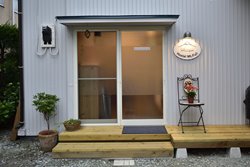 Front entrance |
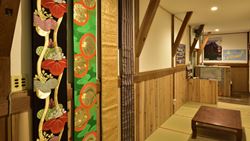 Front desk and TV lounge |
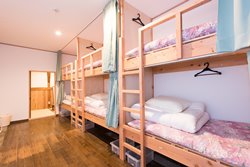 Bunk beds with privacy curtains |
 Double vanity with electric outlets |
(photos courtesy: Hostel Mt. Fuji)
Also, K's House Mt. Fuji, the first backpackers hostel in the Fuji Five Lakes area, is located a 13-min. walk from Kawaguchiko Station.
And in 2015 the Fujigoko Tourism Association put together an excellent restaurant guide with map: Fuji 5 Lakes restaurant guide in English
Aug. 3, 2025 update: Fujisan Gurutto Trip is a site for information about sightseeing around Mt. Fuji, focusing on food, culture, sightseeing spots, & model tours for the World Heritage Site and its surrounding areas.
Q: I recently heard of something called "Diamond Fuji." What is it? (updated Jan. 27, 2024)
One of the most interesting things about Mt. Fuji I've ever experienced while residing in Japan is what's known as "Diamond Fuji," a phenomenon which occurs primarily from Oct. to Feb. when the sun sets into or rises out of Mt. Fuji's cone, setting off sunbeams that resemble a glittering diamond. The Diamond Fuji pic below was taken by a Tokyo friend of mine from the shore of Lake Yamanakako, one of the Fuji 5 Lakes.
Also, on Xmas Day 2014 I decided to put together a webpage listing the best high-rise spots in Tokyo for viewing Diamond Fuji along with recommended dates, sunset times, admission fees, and links to their Google maps. That Diamond Fuji page was updated Jan. 27, 2024 and can be viewed here: Diamond Fuji Viewing Spots, Dates, and Times in Tokyo
Q: How can I get myself in good enough shape to climb Mt. Fuji? (added July 2, 2021)
A: REI (Recreational Equipment, Inc.), the famous outdoor gear and apparel store, has prepared a very comprehensive physical fitness and conditioning guide, complete with videos, to help you properly train for climbing Mt. Fuji. You can view it here.
Q: I'm not confident in my own mountain climbing abilities. Can you recommend a good local mountain climbing guide or tour? (updated Sept. 4, 2025)
A: There are several, in a constant state of flux from year to year, but here are just a few examples I've run across in the past year or so:
- Explore-Share.com - 1-day & 2-day Mt. Fuji climbs with guide
- 2-Day Mt. Fuji Climbing Tour with Mountain Guide, organized by Sunshine Tour
- Fuji Sunrise - small-group, private tours of Mt. Fuji operated by local guide in Fujinomiya, Japan
- Walk on the Wild Side - Mt. Fuji nature guides
- Fuji Outdoor - 2-day Mt. Fuji Sunrise Tour & 1-day Mt. Fuji Tour
- Willer Travel - 2-day bus tour from Tokyo
- Kanto Adventures, run by David Niehoff
- FYG Mountain Guides offers a number of 2-day and 3-day Mt. Fuji pilgrim and sunrise tours
- VIP Tour - guided tours for all 4 Mt. Fuji climbing routes
Q: If I make it to the top of Mt. Fuji, can I get a certificate for my accomplishment? (updated Sept. 12, 2025)
A: Yes, you can get a personalized certificate for ¥1,080 or a commemoration letter for visiting Mt. Fuji for ¥500 from the Japan Mt. Fuji Association. More details here. You can also get a climbing certificate in the Mt. Fuji App after you reach the top.
It was also reported that in 2025 a non-personalized certificate was available from Mt. Fuji's summit post office for ¥700.
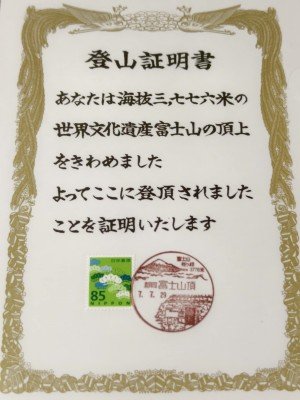
Photo courtesy: Li Chang
In English: "Mountaineering Certificate: You have reached the summit of Mt. Fuji, a UNESCO World Heritage Site at an elevation of 3,776 meters above sea level. This certifies that you have successfully climbed it."
Q: I'm not a mountain climber. Are there guided Mt. Fuji bus tours I can join? (updated May 17, 2024)
A: From the comfort of an air-conditioned motorcoach, you can enjoy not only the beautiful panoramic views from Mt. Fuji's 5th Station, but there are 1-day Mt. Fuji tours starting from around ¥14,000 (with lunch box), some that also take in the nearby Hakone hot spring resort and include a pirate boat cruise on Hakone's Lake Ashi. Here are some of the more popular Mt. Fuji bus tour services:
- Veltra Corporation
- Hato Bus
Q: Are there any races or trail runs up or around Mt. Fuji? (updated Mar. 27, 2025)
A: There are probably more, but I'm currently aware of these:
Sea-to-Summit - The Sea-to-Summit is an endurance charity fundraising event. Climbers trek all the way from the Shizuoka coastline to the summit of Japan's symbolic Mt. Fuji in under 24 hours.
For climbers interested in a more leisurely sea-to-summit trek, Fuji City in Shizuoka Prefecture has laid out a 4-day, 3-night, 42 km (26.1 mi) route named the "Mt. Fuji Tourism Climbing Route 3776" (click on "English" tab), in reference to the elevation gain to Mt. Fuji's summit. Hikers can choose to start from either Tagonoura Port Park or Fujizuka, both of which are at sea level on Suruga Bay.
Fuji City's English/Japanese bilingual guide map includes information on sightseeing and accommodation options along the route and can be found here.
49th Annual Chichibunomiya Memorial Mount Fuji Climbing Relay Race (Japanese) - Sunday, Aug. 4, 2024 - Runners run from Gotemba's 5th Station to the summit of Mt. Fuji, then descend 3258 m down the Gotemba Great Sand Run (supposedly the world's largest elevation drop among relay road races), finishing up at the Gotemba athletics stadium.
Mt. Fuji International Marathon 2025 - Sun. Dec. 14, 2025
Mt. Fuji 100, international trail running event - April 24-26, 2026
21st Mt. Fuji Hill Climb, Japan's largest hill climb cycling race - Sun. June 1, 2025
78th Fuji Mountain Race - Fri., July 25, 2025
Tour of Japan 2025 cycling race - May 18-25, 2025 - Japan's largest cycle road race event
Q: Is it possible to mail a letter or postcard from the summit of Mt. Fuji? (updated Aug. 9, 2025)
A: Yes, by all means don't miss the chance to mail a letter or postcard to your family or friends back home from the highest post office in Japan. The Mt. Fuji summit post office (富士山頂郵便局, Fujisan-cho Yuubin Kyoku) will be open this season from 6 am to 2 pm daily from Thursday, July 10, 2025 to Wednesday, August 20, 2025, including weekends and holidays except on days with inclement weather. It's located at the top of the Fujinomiya Trail, between the Fujikan summit mountain hut (頂上富士館) and the Sengentaisha-Okumiya shrine (浅間大社奥宮), about a 30-40 min. hike clockwise around the summit crater from the top of the main Yoshida trail. More info on Japan's highest post office, including map (in Japanese) is here.
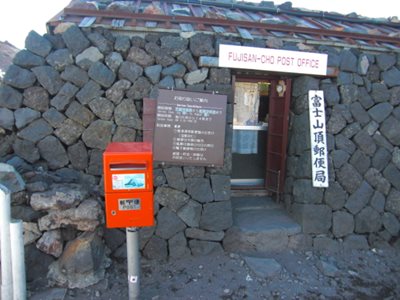
Fujisan-cho post office,
the highest post office in Japan
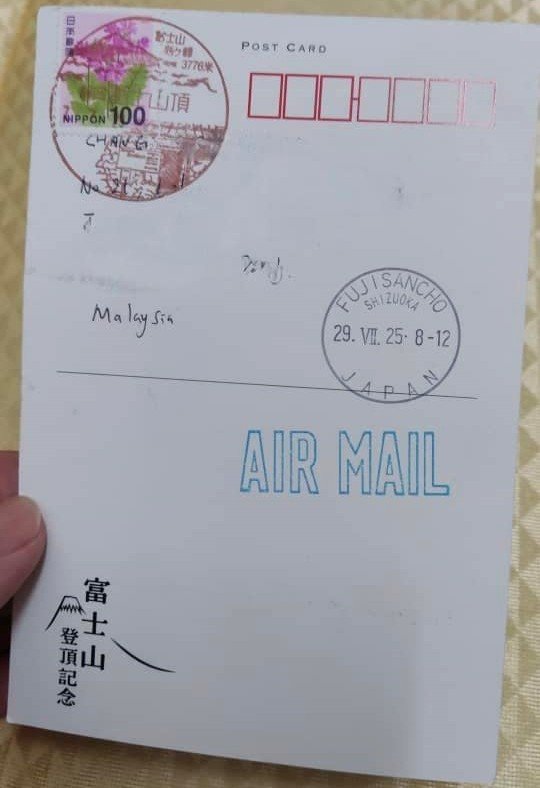
Postcard mailed from Mt. Fuji's summit (Fujisan-cho)
(photo courtesy: Li Chang)
Q: Are there places around Tokyo to rent/buy gear (i.e. hiking boots, warm jackets, headlamps) when climbing Mt. Fuji? (updated Mar. 27, 2025)
A: I'm sure this short list of online shops just scratches the surface, but it's a start:

- http://mtfujirental.com/
- http://lamont.jp/en/ (in Fuji-Kawaguchiko-cho, near the entrance to the Fuji Subaru Line)
- http://www.yamarent.com/
- https://tour.vipliner.biz/fuji/rental/?tm=1682563140&lang=ENG
- https://www.cuterek.com/ (Japanese)
Also, outdoor gear shops in Tokyo are in a constant state of flux, and this list is a bit outdated, but some of these may offer rentals:
- Kojitsu-sanso in Ikebukuro West Exit: https://www.kojitusanso.jp/shop/kanto/ikebukuronishiguchi/
- Ishii Sports Yodobashi Shinjuku Nishiguchi: http://www.ici-sports.com/shop/shinjuku_west/ (west side of Shinjuku Station, just a short walk from the Busta Shinjuku bus terminal, the departure point for the Shinjuku to Mt. Fuji 5th Station highway bus)
- Ishii Sports Tozan Honten: http://www.ici-sports.com/shop/honten.html (in Kanda Jimbocho)
- Haglofs Japan main page: http://haglofs.jp (Japanese) - shop in central Tokyo is in Harajuku
- Mammut Japan: https://www.mammut.jp - Tokyo area stores in Marunouchi, Shibuya, & Shinjuku
- Montbell (Japanese):
http://store.montbell.jp/search/shopinfo/?shop_no=618851 (Shibuya)
https://store.montbell.jp/search/shopinfo/?shop_no=618950 (Shinagawa)
http://store.montbell.jp/search/shopinfo/?shop_no=618937 (Shinjuku Station south exit)
https://store.montbell.jp/search/shopinfo/?shop_no=678596 (Ikebukuro Tobu dept. store)
Google Map of all Montbell shop locations in Japan
Q: Does it really cost ¥1000 to climb Mt. Fuji? (updated Mar. 28, 2025)
A: Beginning with a 10-day trial period in the 2013 climbing season and implemented in 2014 for the entire season, Mt. Fuji climbers were asked to donate ¥1000 to help enhance activities and services for environmental conservation, climber safety, and information provision. In particular, the voluntary fees were being used to construct new lavatories and repair existing ones, increase the number of personnel engaging in conservation efforts, and to expand the number of first-aid centers. Also, the study of new toilet technologies, surveys to monitor and analyze climber trends, setting up additional information centers, installing signage to raise awareness of climbing etiquette and rules, increasing the safety of the down trails such as the repair of protective fences, and developing mobile device apps and videos (for guidance in English, Chinese, Korean, Spanish, and Portuguese) to help climbers better understand climbing safety and environmental conservation.
Update: Beginning in 2024, Mt. Fuji climbers who passed through the entrance gate at the Yoshida Trail 5th station payed a mandatory fee of ¥2,000 per person & the ¥1000 donation remained optional. In 2025 the entry fee will be ¥4,000 per person for all 4 trails & the optional ¥1000 donation will be dropped.
[Note: Speaking of environmental conservation, because the 3 trails from Shizuoka Prefecture don't usually open till July 10, some if not all public toilets around the Mt. Fuji summit area (which lie in Shizuoka Prefecture) may be unavailable each year during July 1-9. Climbers planning to summit Mt. Fuji during the 1st 9 days of the season are asked to bring personal disposable toilets just in case, and which are not a bad idea throughout the season, given their usefulness in the case of congestion or emergencies. In 2014, human excrement was found at 17 places along the Subashiri route.]
The funds from the ¥1000 donation were not used to maintain existing toilet facilities, including those installed in mountain huts. Because funds to maintain these existing toilets are not included in Fuji-san's general operating budget, climbers are asked to pay a small fee (¥200‒¥300) when using these toilets.
All of these environmental efforts are imperative in assisting Japan to submit periodic favorable state-of-conservation reports to UNESCO’s World Heritage Center in order for Mt. Fuji to retain its World Heritage Site status.
In 2021 climbers who supported the conservation of Mt. Fuji by donating received a cute little wooden tag of appreciation which reads "Certificate of Cooperation in the Conservation of Mt Fuji." The tags are made out of recycled fallen timber from Mt. Fuji.
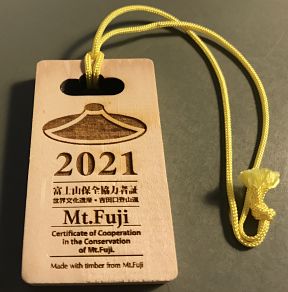
2021 Mt. Fuji conservation donation wooden tag
Q: Where are Mt. Fuji's toilets located and are they environmentally-friendly? (added July 6, 2017)
There are toilets at all the mountain huts, plus additional public toilets. The 3 different kinds of toilets all incorporate ecological systems which do not discharge waste. The oyster shell and sawdust toilets stimulate microorganisms that break down the waste. And the incinerator toilets evaporate or burn the waste product. According to Shizuoka Prefecture (where 3 of Mt. Fuji's 4 trails originate), their 24 toilet facilities are used approximately 330,000 times every year, collecting approximately 99 tons of human waste. Wow.
Locations and the 3 types of Mt. Fuji's toilets for all 4 trails are shown in this detailed map prepared by Shizuoka Prefecture.
Q: I've heard that a Japanese university professor predicted Mt. Fuji would erupt by 2015. Should I be concerned? (updated April 27, 2023)
A: Yes, without question, various parts of Japan experienced a very significant increase in volcano activity in the late 2014/early 2015 period, most notably the eruption of Mt. Ontake-san, Japan's 14th highest peak, in September 2014 which killed 57 climbers. In early May 2015, area hiking trails were closed after volcanic activity started at Mt. Hakoneyama in the famous Hakone hot springs area, just 80km southeast of central Tokyo. The volcanic activity then intensfied, prompting the Japan Meteorological Agency in late June 2015 to raise the peak's volcanic alert level to Level 3 (orange triangles on the volcano map - "Do not approach the volcano"). Mt. Hakoneyama lies a mere 30km (~18 mi) from Mt. Fuji.
Meanwhile, both Yamanashi and Shizuoka Prefectures and the City of Fujiyoshida have funded the preparation and distribution of a few thousand sets of safety helmets, goggles, and dust-proof masks to a number of mountain huts along the 4 trails.
But because during the peak of the climbing season as many as 9000 people climb Mt. Fuji every day, local authorities are urging climbers to bring their own helmets, goggles, and masks to protect themselves against a possible Mt. Fuji eruption.
Yamanashi Prefecture is also distributing evacuation route maps to climbers, showing four possible eruption patterns based on the vent’s location and the reach of lava.
[As of Mar. 20, 2020, both Mt. Fuji and Mt. Hakoneyama, only 30km (~18 mi) from Mt. Fuji, remained at Volcanic Alert Level 1 (white triangles on volcano map - "Potential for increased activity").]
Mar. 28, 2021 update: "A volcanic hazard map for Mount Fuji in central Japan has been revised for the first time in 17 years, doubling the estimated volume of lava flows in the event of a major eruption.
It shows far more craters than were in the previous map and estimates that a major eruption would cause a flow of 1.3 billion cubic meters of lava, or about twice as much as previously estimated.
The revised map also shows that lava flows could reach 12 more towns and cities in 3 different prefectures -- including those located more than 40 kilometers away, like Uenohara in Yamanashi Prefecture, Sagamihara and Odawara in Kanagawa Prefecture, and Shimizu in Shizuoka Prefecture.
It also says 96 percent of previous eruptions were minor or medium-sized, but that the next eruption could be a big one."
Source: "Volcanic hazard map revised for Mt. Fuji," JapanBullet.com, Mar. 27, 2021
Q: Will I be able to access the internet while climbing Mt. Fuji? (updated June 25, 2025)
A: Since 2016 Wireless broadband provider Wire & Wireless has offered free wireless Internet access at a total of 47 locations on Mt. Fuji during the official climbing season, including all of the mountain huts along all 4 trails.
Users can access the Fujisan Wi-Fi network by registering their email address or social network account, or by downloading Wire & Wireless' free Travel Japan Wi-Fi app (for iOS and Android devices) from their website linked above.
The Fujisan Wi-Fi network offers support in 6 languages: Japanese, English, Chinese, simplified Chinese, Korean, and Thai.
Source: SoraNews24
June 25, 2025 update: SoftBank Corp. Providing 5G Connectivity on Mt. Fuji Summit for Summer Climbing Season
Every year SoftBank Corp. takes measures to enhance communication services for climbers on Mt. Fuji, including setting up base stations at the summit during the summer climbing season. In 2025, SoftBank is installing “SoftBank 5G” and “SoftBank 4G LTE” communication equipment at the top of Mt. Fuji, which covers the summit and mountain huts. Also, SoftBank provides year-round 4G LTE services at all 4 trailheads – Fujinomiya, Subashiri, Gotemba, and Yoshida trails.
May 9, 2025 update: Climbers wishing to scale Fujisan this year from the 3 Shizuoka trails (Fujinomiya, Gotemba, & Subashiri) need to complete the pre-registration process beginning with installing the Shizuoka Fuji Navi app: https://fujisan223registration.com/2025/en.html
April 2, 2025 update: Also, since 2009 KDDI-au has provided mobile service during Mt. Fuji’s official climbing season (early July to early September). In 2021, they launched 5G coverage at the summit, making it Japan’s highest mobile service point. Unlimited data plans for 4G LTE on the trails & 5G access at the summit are available for KDDI-au's eSIM users.
June 24, 2023 update: During the 2023 Mt. Fuji climbing season, Telecommuncation giants SoftBank Corp. and KDDI Corp. will each provide 5G mobile communication services at Mt. Fuji's summit from early July to late August. And Wire and Wireless Co., Ltd. (Wi2) will provide free public Wi-Fi service at 46 locations around Mt. Fuji including mountain huts from July to early September.
Aug. 29, 2021 update:
In 2021 Yamareco, a community site for climbers to share their mountain climbing records like GPS logs, diaries, and photos, developed the Mt. Fuji app which is a hiking trail map application specially designed for climbing Mt. Fuji. You can check your current location with GPS even where there is no cell phone signal.
It utilizes data such as maps, routes, and place names, and also provides other details like mountain hut info, weather forecasts, recommendations for climbing gear, how to obtain climbing insurance, etc.
Q: I plan to climb all night to catch the sunrise from the Mt. Fuji summit, but I've heard this is unsafe. Is it REALLY that dangerous? (updated Mar. 19, 2017)
A: Because of serious climber safety issues in recent years related to the one-day style of Mt. Fuji climbing called "bullet climbing" ("Dangan-Tozan" (弾丸登山) in Japanese), prefectural officials have worked diligently to educate and warn climbers against doing this, especially 1st-time climbers of Mt. Fuji from overseas, the segment of the climbing population where this seems to be the biggest problem. Climbing incidents most often involve people who view climbing Mt. Fuji like a sightseeing outing and thus fail to make adequate preparations. This sort of 1-day climber tourism is taking a toll on the Fuji-san's delicate environmental balance, and may accelerate future actions to limit the number of climbers on Japan’s holiest peak and newest World Heritage Site.
A recent report by Japan's environment ministry showed that 28% of all 1st-time climbers of Mt. Fuji opt to climb up and down in only one day, starting in the late evening (often despite inadequate fitness) and hiking all night long to reach the summit in time for sunrise. This number is drastically higher for foreign climbers who make up 30% of Mt. Fuji climbers. Furthermore, 14% of bullet climbers (compared to only 5% of standard climbers) give up climbing to the top because they become ill. Plus, the number of bullet climbers who seek help at 1st-aid stations is 3 times higher than that of standard climbers.
One-day bullet climbing is considered dangerous as it increases climber susceptibility to injury, below-normal body temperatures, and altitude sickness, a condition that should never be taken too lightly. The shortage of oxygen supply at high altitudes can cause fatigue, lethargy, and headaches, which in turn may lead to accidents, physical imbalance, dehydration, circulatory system anomalies, and even the possible lethal condition known as cerebral edema, or swelling of the brain caused by excessive fluid buildup.
To avoid safety problems from bullet climbing and altitude sickness, prefectural officials are urging Mt. Fuji climbers to follow a few simple guidelines:
- Get adequate sleep on the day before the climb. Climbers who have not properly slept are more prone to injuries and illnesses due to fatigue. Avoiding alcohol intake on the day before your climb (and during your climb) is also a good measure for warding off high-altitude dehydration.
- At the 5th station before departure, climbers are advised to rest for 1-2 hours before starting the ascent to the Mt. Fuji summit. This will help your body acclimatize to the higher altitude and reduce the risk of altitude sickness.
- Climbers are urged to take their time, pace themselves, and in order to avoid altitude sickness, to stop at mountain huts to take regular, short rest breaks. For example, climb for 25 minutes and rest for 5 minutes, or climb for 50 minutes and rest for 10 minutes.
- In order to avoid getting cold, though (temperatures at the summit may drop below freezing even in July and August), rest stops ideally should not last TOO long.
- In order to prevent dehydration, drink water (or isotonic sports beverages) regularly. Specially formulated sports drinks that replace water and electrolytes and contain either fructose or glucose polymers allow a slow release of carbohydrates for replenishing reserves of energy consumed while climbing. It is not safe nor a good idea to avoid drinking water in order to save time and money on toilet breaks.
- To the greatest extent possible, try to avoid (or at least limit the number of hours) climbing at night. Due to nightime darkness, climbers are more likely to cause rocks to fall, a potential danger to other climbers below. Climbers are urged to stay as close as possible to the inside (slope side) of the trail, as walking along the trail's downhill free edge can cause loose rocks to fall and hit climbers hiking along one of the zigzags below. If you do dislodge rocks causing them to fall, please yell at the top of your lungs to warn others below and around you.
The best way to warn someone about a falling rock is to just shout out "RAKU!" (落!), pronounced "rah-koo," which is the shortcut Japanese expression for "falling rock." This should be easy to remember, as it sounds almost identical to the English word "rock."
Sources for the info above:
For increased safety when climbing Fuji-san (2015 version)
Stop Bullet Climbing!
[One final note. Although sunrise from the Mt. Fuji summit is a big goal of many climbers, one beauty of the main Yoshida Trail is that you can view the sunrise pretty much anywhere above the treeline, which is near the 6th Station.]
Q: I read somewhere that credit cards are not accepted on Mt. Fuji, so how much cash should I bring, anyways? (added July 21, 2015)
A: According to the kind folks at Shizuoka Prefecture's Mt. Fuji World Heritage Division in the Culture and Tourism Department, you might need as much as ¥15,000-20,000, depending on your plans and spending habits. And climbers are recommended to have lots of change on hand (especially numerous ¥100 coins) for meals, drinks, souvenirs, walking stick branding iron stamps, shrine offerings, etc. Mountain hut accommodations will set you back ¥8,000-9,000, bottled drinks will run ¥500-1,000 (¥400-500 per bottle), and pay toilets will cost ¥1,200-1,500 (¥200-300 per use). Toilets on Mt. Fuji are not covered in the general maintenance budget, so are self-supporting and thus require a fee.
Q: Who's the oldest person to have ever climbed Mt. Fuji? (updated July 25, 2019)
A: Just inside the front entrance of the Gogoen Rest House (五合園レストハウス) at the Fuji Subaru Line 5th Station, you'll find a bronze statue erected in honor of Teiichi Igarashi (五十嵐貞一) who on Aug. 8, 1988 scaled Fuji-san at the ripe young age of only 105. Igarashi-san was a retired forest ranger from Furudono, Fukushima who started climbing Japan's tallest peak annually in 1976 in memory of his deceased wife. So at the time of his feat in 1988, he already held the record as the oldest person to reach Mt. Fuji's summit and had renewed his record for 13 years in a row. (Source: Mt. Fuji 5th Station International Tourist Conference)
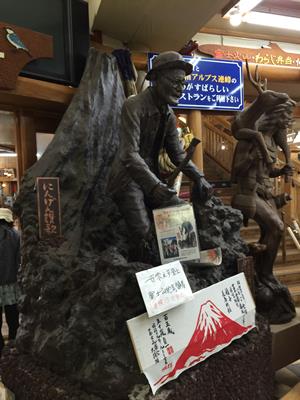
Teiichi Igarashi, age 105, the oldest
person to have ever climbed Mt. Fuji
On July 24, 1987, 91-year-old mountaineer Hulda Crooks from Loma Linda, California became the oldest woman to climb Mt. Fuji. She also successfully scaled California's 14,505-foot (4,421 m) Mount Whitney 23 times between the ages of 65 and 91, earning her the nickname "Grandma Whitney."
Q: Who holds the record for climbing Mt. Fuji the most number of times? (added June 23, 2025)

A: As of Sept. 2023, it was reported that 80-year-old mountaineer Yoshinobu Jitsukawa (實川欣伸), known as "Mr. Fuji," had climbed Japan's tallest peak a record 2,230 times! WOW! Jitsukawa, a resident of Numazu in Shizuoka Prefecture, made his first ascent of Mt. Fuji in the summer of 1985 when he went with his family at the age of 42.
After then becoming insanely passionate about scaling Fujisan, thru the years he's known to have often climbed Mt. Fuji twice a day and more than 200 times a year. Starting from the Fujinomiya 5th station, in a single day he could make 2 round trips to the summit in 8-10 hours.
He has also succeeded in completing 8 consecutive round trips in about 55 hours and climbing all 4 routes in one go in about 31 hours. In 2014 Jitsukawa surpassed the previous record of 1,672 times set by Fusakichi Kaji (1900-1967), a legendary mountain porter ("goriki"), a person who carries cargo high up in the mountains.
He's also conquered the highest peaks on 6 continents, but has given up on scaling Everest after 3 failed attempts, the last time partially losing 3 fingers on his left hand from frostbite.
Q: Where are the most congested spots on Mt. Fuji's Yoshida Trail? (updated Mar. 19, 2017)
A: Congestion occurs frequently before sunrise at the spots on the Yoshida Trail shown below, especially between the Goraiko-kan mountain hut at the 8.5th Station and the Kusushi-Jinja Shrine at the top of the trail, including around the 9th Station.
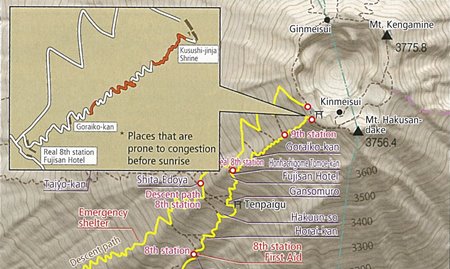
Yoshida Trail congestion spots
(Source: "Fujitozan Advice Book," published by
the Mt. Fuji Preservation Promotion Section)
Q: Where are the most hazardous places on Mt. Fuji's Yoshida Trail? (updated Mar. 19, 2017)
A: As shown below, one place worth noting is between the 9th Station and the top of the Yoshida Trail where the trail is particularly narrow and there is a chance of falling rocks. Another place is between the Hanagoya mountain hut at the 7th Station and the Horaikan mountain hut at the 8th Station where there are steep rocks and a very narrow, single-file trail.
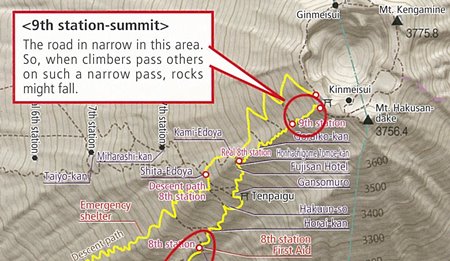
Yoshida Trail hazardous places - 9th Station to top of trail
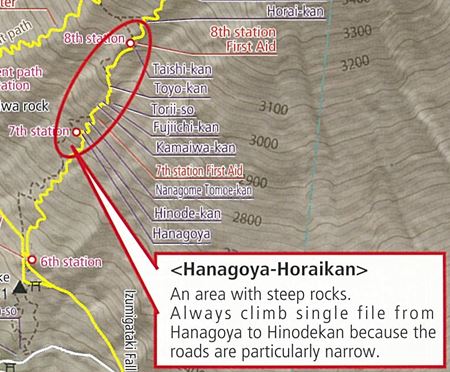
Yoshida Trail hazardous places - Hanagoya to Horaikan
(Source: "Fujitozan Advice Book," published by
the Mt. Fuji Preservation Promotion Section)
Q: Is camping allowed on Mt. Fuji? (added May 30, 2020)
A: There are no designated campsites along any of the climbing routes nor at the summit of Mt. Fuji, which lies within Fuji-Hakone-Izu National Park. And so pitching tents, making fires, or camping of any sort is expressly forbidden. As Japan's holiest peak, also designated as a Special Place of Scenic Beauty, Historic Site, and since 2013 a World Heritage Cultural Site, according to Fujisan's official website, the following acts are also legally prohibited on Mt. Fuji:
- Disturbing animals and plants
- Removing lava from the area
- Releasing pets, etc.
- Sowing seeds or planting seedlings
- Defacing natural features, including spray painting
graffiti on rocks (sadly, it really DOES happen!

Q: Where
can I get more helpful info on climbing Mt. Fuji? (updated Mar. 28, 2025)
A: Mt.
Fuji Yoshida-Guchi Trail Climbing Guide
Map,
published Nov. 2013 by Fujiyoshida City (added Feb. 26, 2015) (more
recent Mt. Fuji trail maps are listed in the maps question above)
Yamanashi Fujitozan Advice Book
Mt. Fuji (富士山) topo
map (from the Geospatial Information Authority of Japan)
2025 Mt. Fuji
(富士山) route map (part of the
Yama-to-kogen Chizu series published
by Shobunsha, available in bookstores and from Amazon Japan)
http://www.japan-guide.com/e/e6901.html
Mt. Fuji Climbing Guide
http://wikitravel.org/en/Mount_Fuji
"My Experience at a Part-time Job at the Altitude of
3100 Meters,"
an interesting story posted Sept. 23, 2021 by a Japanese university
student who worked at the 8th Station Taishikan (太子舘) mountain hut.
The Unconventional Guide to Climbing Mt. Fuji
(12
insider tips from
a guy who worked 37 straight days from 5:30 am till 9 pm every day
cleaning toilets in a Mt. Fuji mountain hut)
Emergency phone numbers (during climbing season):
- Mt. Fuji 5th Station General Administration Center: 090-5190-0167
(also emergency phone number for climbers)
- Mt. Fuji 6th Station Safety Guidance Center: 0555-24-6223
Fuji Subaru 5th Station General
Management
Center: 0555-72-1477
Fujiyoshida Tourist Info Center: 0555-22-7000
Fujikawaguchiko Tourist Info Center: 0555-72-6700
Fujikyuko express buses bound for Mt. Fuji area
International Affairs Desk, Fujiyoshida City Hall (8:30-17:15,
Mon.-Fri.): 0555-24-1236 (+81-555-24-1236 from overseas)
Please stop by again soon
Thank you very much for visiting these pages, and if you by chance have already had the pleasure of climbing Mt. Fuji, I hope you will by all means take a few minutes to share your story on Page 1 with future climbers. Please stop by again soon, as I intend to continue updating these pages with more details in the future, as they become available.
If you have any questions for me, please give me a shout by clicking on the "Contact Me" link. And if you're planning to climb Japan's highest peak, I wish you my most heartfelt good luck!!
Cheers,
Gary
Back
to the Highest Mountains in Japan

A FREE download at Smashwords
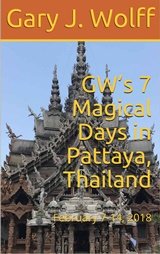
Only $1.99 at Amazon
(¥214 at アマゾン日本)
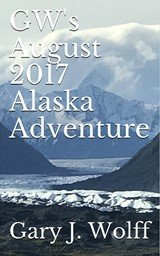
Only $2.99 at Amazon
(¥340 at アマゾン日本)
Japan Mountain Pages:
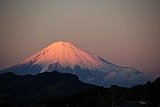
Climbing Mt. Fuji - FAQ
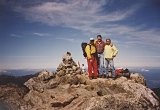
Mt. Kita-dake
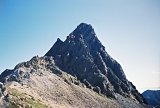
Mt. Oku-hotaka-dake
& Mt. Yari-ga-take
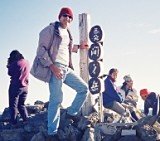
Mt. Ai-no-dake &
Mt. Shiomi-dake
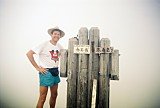
Mt. Warusawa-dake
& Mt. Akaishi-dake
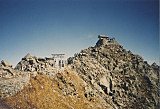
Mt. Tateyama &
Mt. Tsurugi-dake
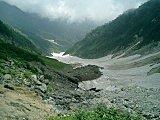
Mt. Shirouma-dake
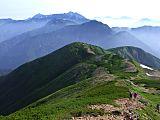
Mt. Yakushi-dake
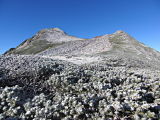
Mt. Kasagatake
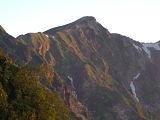
Mt. Kashimayari-ga-dake
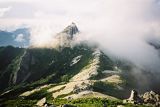
Mt. Suisho-dake &
Mt. Washiba-dake
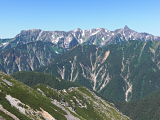
Mt. Jonen-dake
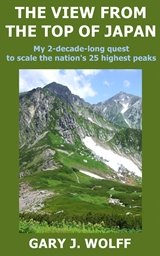
Only $2.99 at Amazon
(¥343 at ア マゾン日本)
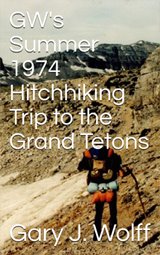
Only 99¢ at Amazon
(¥105 at アマゾン日本)
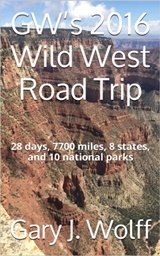
Only 99¢ at Amazon
(¥114 at アマゾン日本)
What's New?
-
Don't ever stop working!
Dec 22, 25 07:17 AM
"Most of us spend our entire lives chasing the dream of having enough. What happens when that goal is met? Do we stop or is there reason to keep working anyway? If you have more to look back on than y… -
CDC Vaccine Panel Votes to End Universal Hepatitis B Vaccine for All Newborns
Dec 12, 25 10:00 AM
Advisers to the Centers for Disease Control and Prevention (CDC) this morning voted to end a decades-long recommendation that all infants born in the U.S. receive the hepatitis B vaccine within 12-24… -
The 2025 Fall Colors (紅葉) season...
Dec 12, 25 09:00 AM
...in Tokyo has finally arrived in earnest. This kind of beautiful scenery brings a lot of childhood joy to folks like myself, even after 3 decades here, as there is nothing even close to this in my h…

